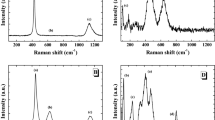Abstract
Two adjacent fuel rod segments were irradiated in a pressurized water reactor achieving an average burn-up of 50.4 GWd/tHM. A physico-chemical characterisation of the high burn-up fuel rod segments was performed, to determine properties relevant to the stability of the spent nuclear fuel under final disposal conditions. No damage of the cladding was observed by means of visual examination and γ-scanning. The maximal oxide layer thickness was 45 μm. The relative fission gas release was determined to be (8.35 ± 0.66) %. Finally, a rim thickness of 83.7 μm and a rim porosity of about 20% were derived from characterisation of the cladded pellets.
Similar content being viewed by others
References
D.R. Olander. Technical Report TID-26711-P1, California University (1976).
Hj Matzke, H. Blank, M. Coquerelle, K. Lassmann, I. L. F. Ray, C. Ronchi, C. T. Walker. J. Nucl. Mat. 166, 165–178 (1989).
D. Papaioannou, R. Nasyrow, W. De Weerd, D. Bottomley, V. V. Rondinella. Non-destructive examinations of irradiated fuel rods at the ITU hot cells, 2012 Hotlab conference, 24th-27th September 2012, Marcoule, France (2012).
H. Kleykamp. Technical Report KfK-3394 (1983).
D.H. Wegen, D. Papaioannou, R. Gretter, R. Nasyrow, V. V. Rondinella, J.-P. Glatz. KIT scientific report 7639, p.193–199 (2013).
T. Sakugari, H. Tanabe, E. Hirose, A. Skashita, T. Nishimura. Proc. 15th Intl. Conf. Envir. Remed. Rad. Waste Manag., September 2013, Brussels, Belgium (2013).
F. Garzarolli, M. Garzarolli, P. Rudling. ed. High Burnup Fuel Design Isssue and Cosequences (Advanced Nuclear Technology International, Mölnlycke, Sweden, 2012) p. 41.
KORIGEN code. http://www.nucleonica.net/Application/Korigen.aspx
V. Metz, {etet al},. Deliverable No: 1.2, pp. 85 (2013).
L. Johnson, I. Günther-Leopold, J. Kobler Waldis, H.P. Linder, J. Low, D. Cui, E. Ekeroth, K. Spahiu, L.Z. Evins. J. Nucl. Mat. 420 54–62 (2012).
L. Johnson, C. Ferry, C. Poinssot, P Lovera. J. Nucl. Mat., 346, 56–65. (2005)
Y.-H. Koo, B.-H. Lee, J.-S. Cheon, D.-S. Sohn. J. Nucl. Mat. 295, 213–220 (2001).
Acknowledgments
We acknowledge F. Weiser (KfK-HZ, KIT) for performing the ceramography of N0203 pellets. The research leading to these results has received funding from the European Atomic Energy Community’s Seventh Framework Programme (FP7/2007-2011) under grant agreement no. 295722, the FIRST-Nuclides project.
Author information
Authors and Affiliations
Rights and permissions
About this article
Cite this article
González-Robles, E., Wegen, D.H., Bohnert, E. et al. Physico-chemical characterization of a spent UO2 fuel with respect to its stability under final disposal conditions. MRS Online Proceedings Library 1665, 283–289 (2014). https://doi.org/10.1557/opl.2014.656
Published:
Issue Date:
DOI: https://doi.org/10.1557/opl.2014.656




